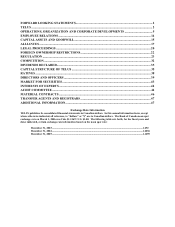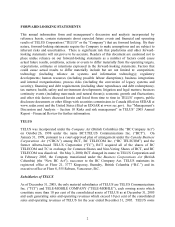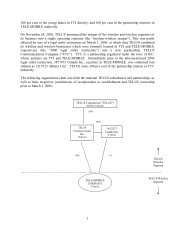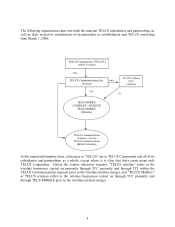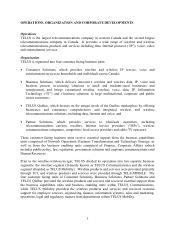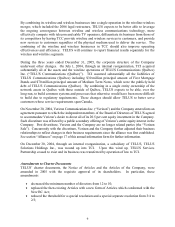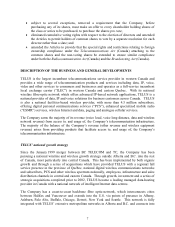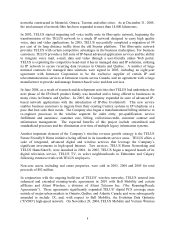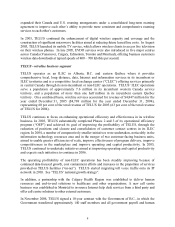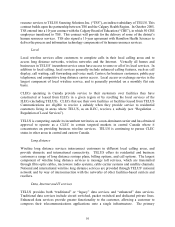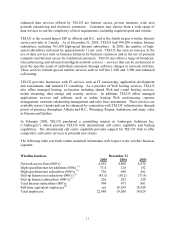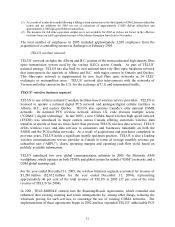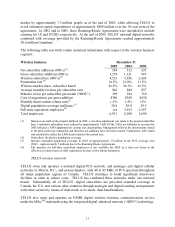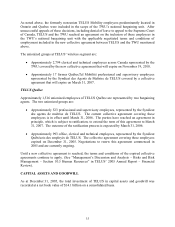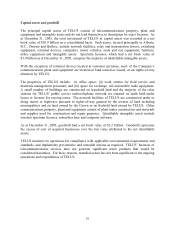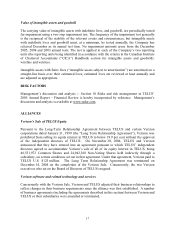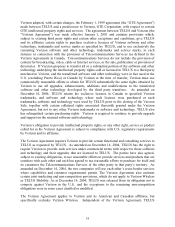Telus 2005 Annual Report Download - page 9
Download and view the complete annual report
Please find page 9 of the 2005 Telus annual report below. You can navigate through the pages in the report by either clicking on the pages listed below, or by using the keyword search tool below to find specific information within the annual report. 8
networks constructed in Montréal, Ottawa, Toronto and other cities. As at December 31, 2005,
the total amount of network fibre has been expanded to more than 14,000 kilometres.
In 2003, TELUS started migrating toll voice traffic onto its fibre-optic network, beginning the
transformation of the TELUS network to a single IP network designed to carry high quality
voice, data and video applications. In 2005, TELUS successfully completed a migration of 99
per cent of its long distance traffic from the old Stentor platform. This fibre-optic network
provides TELUS with certain competitive advantages in the business marketplace. For business
customers, TELUS provides a full suite of IP-based advanced application services and the ability
to integrate voice mail, e-mail, data and video through a user-friendly online Web portal.
TELUS is exploiting the competitive head-start it has in managed data and IP solutions, utilizing
its IP network to secure recurring data revenues in Ontario and Québec. A number of large
national contracts for managed data solutions were signed in 2005, including an eight-year
agreement with Intrawest Corporation to be the exclusive supplier of certain IP and
telecommunications services at Intrawest resorts across Canada, and an agreement with a large
manufacturer to provide and manage Internet-based voice and data services.
In June 2004, as a result of research and development activities that TELUS had undertaken, the
next phase of the IP-One product family was launched and is being offered to businesses in
many cities in Ontario and Québec. In 2005, the Company expanded its suite of advanced IP-
based network applications with the introduction of IP-One Evolution. This new service
enables business customers to migrate from their existing Centrex systems to IP telephony at a
pace that best suits their needs. The Company also began a transformational billing initiative to
re-engineer processes in the wireline segment for order entry, pre-qualification, service
fulfillment and assurance, customer care, billing, collections/credit, customer contract and
information management. The expected benefits of this project include streamlined and
standardized processes and the elimination over time of multiple legacy information systems.
Another important element of the Company’s wireline revenue growth strategy is the TELUS
Future Friendly Home initiative being offered in its incumbent service areas. TELUS offers a
suite of integrated, advanced digital and wireless services that leverage the Company’s
significant investments in high-speed Internet. Two services, TELUS Home Networking and
TELUS HomeSitter, were launched in 2004. In 2005, TELUS began a targeted launch of its
digital television service, TELUS TV, in select neighbourhoods in Edmonton and Calgary
following extensive trials with TELUS employees.
Non-core assets, including real estate properties, were sold in 2003, 2004 and 2005 for total
proceeds of $92 million.
In conjunction with the ongoing build-out of TELUS’ wireless networks, TELUS entered into
enhanced and extended roaming/resale agreements in 2001 with Bell Mobility and certain
affiliates and Aliant Wireless, a division of Aliant Telecom Inc. (“the Roaming/Resale
Agreements”). These agreements significantly expanded TELUS’ digital PCS coverage areas
outside of major urban markets in Ontario, Québec and Atlantic Canada and were subsequently
amended to include 1X, and, with respect to Bell Mobility, the Evolution Data Optimize
(“EVDO”) high-speed network. On November 29, 2004, TELUS Mobility and Verizon Wireless


